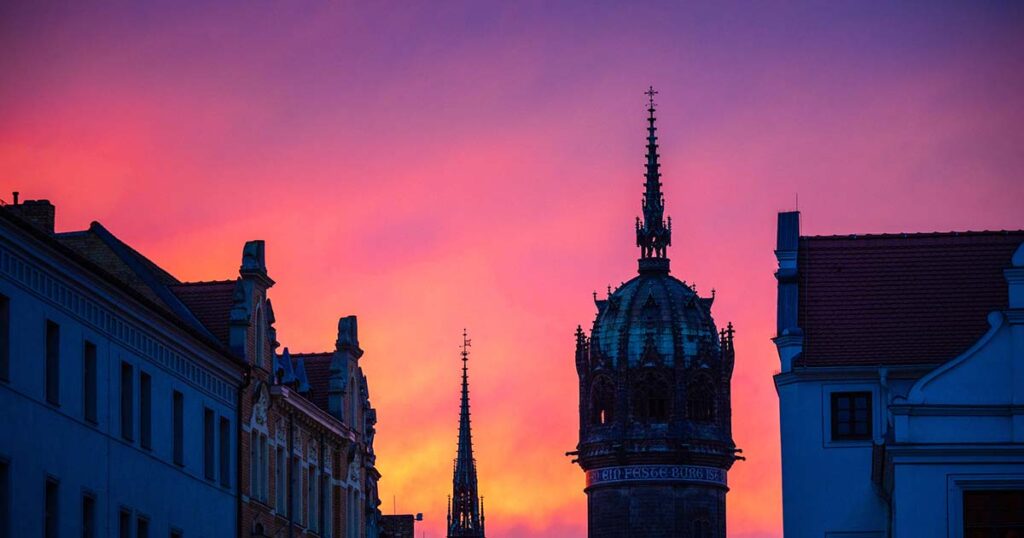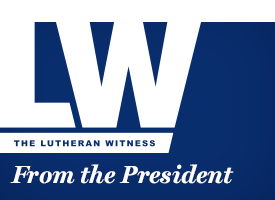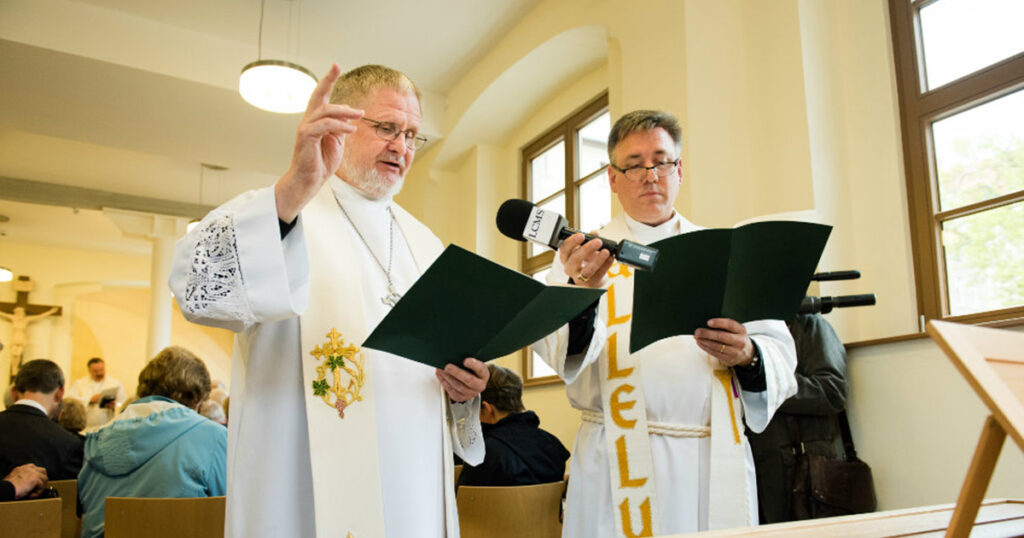Much as in the days of Martin Luther, today a person can begin walking from the Elster Gate on the east end of the old town of Wittenberg and move on past Luther’s home in the Augustinian “Black” cloister, the house of Philip Melanchthon (constructed for the professor and his family in 1536), and the university building in its expanded form. One can then proceed down the Collegien Street (Collegienstrasse) to the city market. The Elbe River runs parallel to the Collegien Street roughly a third of a mile away; occasionally in Luther’s day and even today flood waters edge onto the Collegien Street. At the marketplace, the town hall, constructed during Luther’s career in the town, presides over the square where Luther and Melanchthon did their grocery shopping and where statues of the two now stand. Tucked into its own large courtyard around a corner from the marketplace stands the town Church of Saint Mary, where Luther preached most of his sermons. From Wittenberg’s pulpit he won a local following, first as an Augustinian brother and later as a helper for his colleague and friend, Pastor Johannes Bugenhagen.
The Collegien Street continues under the name Castle Street (Schlossstrasse), to the castle at Wittenberg’s door to the west, the Coswig Gate (neither gate still stands). In 15 minutes or less from his home, Luther reached the place where courtiers conducted much of the business of electoral Saxony. He could then take a very sharp right and walk along the town wall. Parts of the wall dated back to the 14th century, but it was being completed during the last 20 years of the reformer’s life. In some 10 minutes he would have reached the only other monastic establishment in town, the Franciscan cloister, at the northern point of a rough triangle. Another slight right, and following a somewhat rounded path, he reached the Elster Gate again and was just a few paces from home.
Visitors to Wittenberg in 2022 can take the same walk and experience how small the area is in which the events of the Reformation unfolded. With its 2,200 inhabitants around 1520, Wittenberg was only one-twentieth of its current size, but the city has expanded geographically much beyond Luther’s narrow precincts into what were then fields and meadows of peasants living near their marketplace. Fewer people reside there today than did in Luther’s day within the green mounds that indicate where the town wall, completed in 1549 and dismantled in the 19th century, lay.
The Black Cloister was expanded several times and now houses an excellent museum that can easily consume an entire morning or afternoon for interested tourists. The university, called the Leucorea (the Greek equivalent of “Wittenberg,” “white mountain,” though hardly a rise in the Elbe valley is in sight), was merged with the University of Halle and moved from Wittenberg in the post-Napoleonic settlements of the 1810s. Nonetheless, the university in Halle maintains a presence in the buildings in which Luther’s colleagues lectured. Conferences and exchange student programs bring people from around the world to the Leucorea for the experience of Wittenberg.
Although Luther’s pulpit in the town church has found a home in the Lutherhaus museum, and the current altar there dates back to soon after his death, visitors get a sense of the space in which his proclamation of God’s Word resounded over townspeople and students alike. His students took his model and his message to most corners of the German-speaking lands and many points beyond. This laboratory of the reformers for good preaching hosts regular worship services and displays early Lutheran altar pieces and other 16th- and 17th-century artwork, especially the altar created by Lukas Cranach the Younger in 1547. Cranach grew up with Luther, a frequent presence in his family home on the marketplace. Cranach’s father, Lukas the Elder, and brother Martin from the Augustinian cloister had formed a fast friendship more than 30 years earlier. This altar reminds today’s visitors of the centrality of the Means of Grace — the preached Word, Baptism, Absolution and the Lord’s Supper — in the lives of those who hear the Word and receive the Sacraments in that place. Outstanding organs and organists grace the church in worship and concerts. The same is true in the Castle church.
On the marketplace stands the Cranach home and workshop, where great art was produced and books printed. They are open to visitors, as are the homes of Melanchthon and Bugenhagen. Both provide interested tourists with a feel for the time when Wittenberg was throbbing with the thrill of leading reform and flirting with disaster for its defiance of emperor and pope. That defiance focused on the castle at the west end of the Castle Street. Badly damaged in the Seven Years’ War in 1760 and the War of Liberation against Napoleon in 1814, the castle no longer functioned as part of Saxony’s government or of the Prussian government that assumed rule over the area after the Congress of Vienna of 1815. But its church remained, where once the pious gained indulgences from Frederick the Wise’s collection of relics and students heard professors lecture — and theses for public disputation were indeed posted on the door (as was true also on other public doors in town) by scholars of the university. In the 19th century, the German imperial government invested in a massive restoration of the Castle church. Its renovation for the Luther Year of 2017 retained the 19th-century style of celebrating the German Reformation. Recent reconstruction of elements of the castle have provided rooms for the vicarage seminary of several territorial churches in eastern Germany; the Reformation History Research Library, which provides excellent collections and facilities for those researching the Reformation; and a Center for Christian Art.
The rule of the town by Soviet forces and their allied German government in the German Democratic Republic changed Wittenberg in many ways. Less than 10% of its population claims membership in Christian churches today. The town’s dependence on its ever more obsolete chemical factories proved economically disastrous, with only about 10% of the employees in 1989 retaining their jobs a few years later. Tourism had always aided Wittenberg’s economy, and that has been truer in recent years than ever before. With the lifting of COVID-19 restrictions, tourists are once again filling the streets of the old town, enjoying the rich variety of cafes and restaurants, with a range of good German cooking and beverages as well as the international flavors of Germany today. Too many shop fronts remain vacant, and a few buildings still show the worsened wear and tear of a century without repair and renovation. But many fine stores provide merchandise for daily use and gifts that delight tourists and their families and friends back home.
In the heart of the old town, on the courtyard of the town church, over two levels of earlier burial grounds, the town built a secondary school in 1564–1567. The building’s service as a school ended in the late 19th century, and a printing operation and a textile manufacturer made use of the building into the 1980s. In 2006, The Lutheran Church—Missouri Synod, an LCMS German partner church, the Independent Evangelical Lutheran Church of Germany, and Concordia Publishing House purchased the dilapidated structure and began the extensive and expensive task of renovation under the supervision of the Rev. David Mahsman.
In 2019, Dr. Wilhelm Weber, a pastor of the Free Evangelical Synod in South Africa, former bishop of the Lutheran Church in South Africa and rector of Lutheran Theological Seminary in Pretoria, became director of the building, renamed the Old Latin School (Alte Latin Schule). Weber’s open door at the OLS brings individuals, families and groups that visit Wittenberg into what he calls “a home and address for confessional Lutherans in this historic setting,” “a place for sharing the Luther experience in this old Luther city.” Weber explains that the OLS strives to do so “with divine services and missionary outreach, but also with theological workshops, spiritual retreats and conferences and by offering seminars, sabbaticals and research opportunities.” Worship services take place in the chapel of the school, alternating between German and English each Sunday at 8:30 a.m., and in Ukrainian at 10 a.m. Other programs bring visitors in contact with Wittenberg residents in a weekly English Stammtisch and provide support for visiting groups that wish to deepen their roots in the Lutheran confession of the faith. Weber states, “I pray, that the Old Latin School will be able to provide necessary staff and support, so that Lutherans and other visitors from across the world will find this place to be hospitable, open and a wonderful venue to stay and grow in love, hope and faith.” This makes Wittenberg all the more worth a visit.
Photo: LCMS Communications/Erik M. Lunsford





The time at present: Believers/ Christians wall themselves in by the denomination barriers. Way back when, Paul wrote letters and instructed people, cautioning about this and other decaying characteristic actions. We who 1. love God with our whole mind and heart and body and all our strength and 2. love our neighbor as ourselves, for the love of God, really get morally messed up by church leaders forcing the filter of denomination on people. Join the Christian splintering of denomination disable the body of Christ? God bless us all?
Charles,
I encourage you to watch the website; next month’s issue deals with denominationalism. I pray it’s helpful in answering some of your questions.
RSA
This wonderful article about Wittenberg taking the reader on a verbal tour, and the best you can reply with is a dirge chastising the author (?) about an issue (denominationalism) which isn’t really the point of the article at all?
Please go be a boor somewhere else, and to the author, well done, thank you.